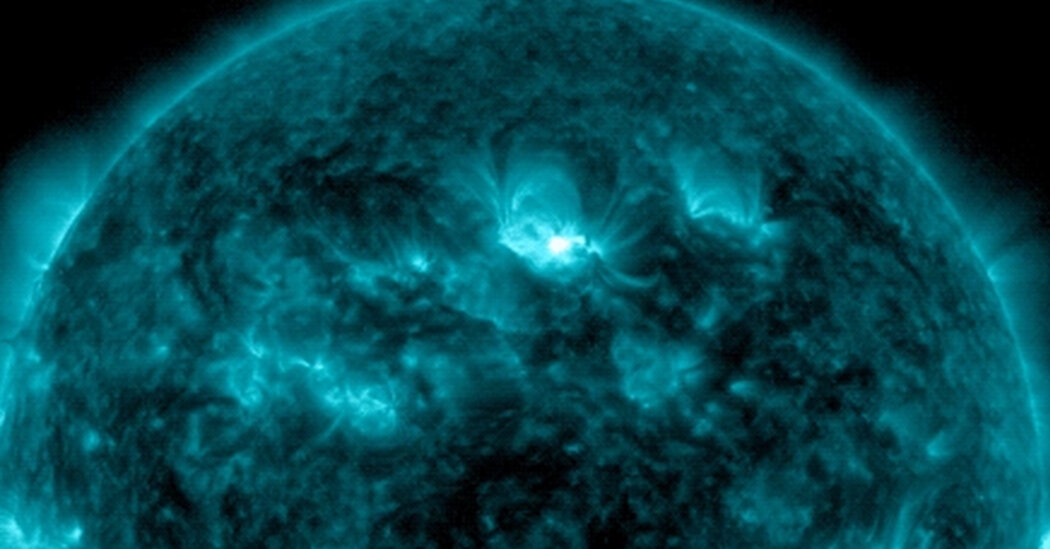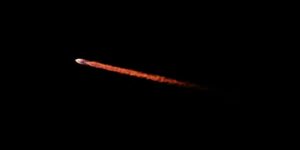The dramatic bursts of particles from the sun’s surface prompted the National Oceanic and Atmospheric Administration to issue a severe geomagnetic storm warning.
As the sun undergoes nuclear reactions, it routinely ejects material from its surface. This type of space weather is what creates the aurora borealis, also known as the northern and southern lights, depending on which hemisphere you live in. During the current geomagnetic storm, the aurora could extend as far south as northern California or Alabama.
But when the sun’s activity increases, the emissions it sends through the solar system can affect satellites in near-Earth orbit as well as earth’s infrastructure, causing disruptions to navigation systems, radio communications and even the power grid.
The latest flares were first seen early Wednesday morning, with at least five aimed at Earth. The ejected material is expected to reach the planet’s atmosphere by Friday afternoon or evening. The effects may last through the weekend.
“What we’re expecting over the next few days should be more significant than what we’ve seen, certainly so far,” Mike Bettwey, chief of operations at NOAA’s Space Weather Prediction Center, said at a news conference Friday morning. .
How strong is the current geomagnetic storm?
Giant explosions on the sun’s surface, known as coronal mass ejections, send streams of energetic particles into space. But the sun is large, and such bursts may not cross our planet as it orbits the star. But when these particles create a disturbance in the Earth’s magnetic field, it is known as a geomagnetic storm.
NOAA classifies these storms on a “G” scale of 1 to 5, with G1 being minor and G5 being extreme. The most extreme storms can cause widespread power outages and damage to Earth’s infrastructure. Satellites may also have problems with orientation or sending or receiving information during these events.
The current storm is classified as G4 or “severe”. It is caused by a group of sunspots – dark, cool areas on the sun’s surface – that are about 16 times the diameter of Earth. The cluster flares up and ejects material every six to 12 hours, with the most recent activity occurring around 3 a.m. ET on Friday.
“We expect to get a back-to-back shock over the weekend,” said Brent Gordon, chief of the Space Weather Services Branch at NOAA’s Space Weather Prediction Center.
How will the G4 storm affect people on Earth?
Unlike tornado watches and warnings, the intended audience for NOAA’s announcements is not the public.
“For most people here on planet Earth, they won’t have to do anything,” said Rob Steenberg, a space scientist at NOAA’s Space Weather Prediction Center.
Instead, a geomagnetic storm observation or warning indicates that space weather may affect critical infrastructure on or in near-Earth orbit. It can introduce additional current into systems, which can damage pipelines, railroads, and power lines.
The purpose of the notices is to give time to the agencies and companies that manage this infrastructure to put in place protective measures to mitigate the possible effects.
“If everything works as it should, the network will be stable and they will be able to go about their daily lives,” Mr. Steenberg said.
Will I be able to see the aurora borealis?
It is possible that the northern lights will grace the skies over places where it is not normally seen this weekend. It is best to see them in a place outside the bright lights of the cities.
But Friday night could bring some weather problems in some places. The northeast is likely to be covered with clouds.
There’s a chance the skies will cooperate in the Midwest, but the time will be closer to sunrise on Saturday. A storm system will move through the region and if it rotates, there will be clear skies behind the storms. Your ability to catch a view will depend on your location and the exact timing of the storm system.
If the aurora reaches as far south as Alabama, which could happen with a G4 storm, the night sky will be relatively clear in northern Alabama and Georgia. Areas in the Southern Plains and Rocky Mountains may have relatively poor viewing conditions.
Further west, the coastal states will remain relatively cloud-free, which could provide good viewing conditions. There may be high clouds in the mountains of Washington, but there is still a chance for clear skies.
If you’re in a clear area, even well south of where the aurora is predicted, take a photo or record a video with your cell phone. The camera sensor is more sensitive to the wavelengths generated by the aurora and can create an image that you cannot see with the naked eye.
Another option could be sunspot viewing during the day if your skies are clear. As always, do not look directly at the sun without protection. But if you still have eclipse glasses from the April 8 event, you can try using them to try to spot the cluster of sunspots causing the activity.
Why is this happening now?
Solar activity waxes and wanes on an 11-year cycle, and right now it’s approaching solar maximum. Three other severe geomagnetic storms have been observed so far in the current cycle of activity that began in December 2019, but none are predicted to cause strong enough effects on Earth to warrant a watch or warning message.
The sunspot cluster generating the current storm is the largest seen this solar cycle, NOAA officials said. They added that activity this cycle has exceeded initial forecasts.
More eruptions and ejections from this cluster are expected, but due to the sun’s rotation, the cluster will be oriented in a position that is less likely to impact Earth. In the coming weeks, sunspots may reappear on the left side of the sun, but it is difficult for scientists to predict whether this will trigger a new bout of activity.
“They usually don’t come out as strong as they initially did,” said Sean Dahl, a forecaster at NOAA’s Space Weather Prediction Center. “But time will tell.”


